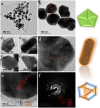Apoptotic efficacy of multifaceted biosynthesized silver nanoparticles on human adenocarcinoma cells
- PMID: 30254325
- PMCID: PMC6156419
- DOI: 10.1038/s41598-018-32480-5
Apoptotic efficacy of multifaceted biosynthesized silver nanoparticles on human adenocarcinoma cells
Abstract
Metallic nanoparticles (NPs) especially silver (Ag) NPs have shown immense potential in medical applications due to their distinctive physio-chemical and biological properties. This article reports the conjugation of Ag NPs with Rubus fairholmianus extract. The modification of Ag NPs was confirmed using various physico-chemical characterization techniques. The cytotoxic effect of Rubus-conjugated Ag NPs (RAgNPs) was studied by LDH assay and proliferation by ATP assay. The apoptotic inducing ability of the NPs were investigated by Annexin V/PI staining, caspase 3/7 analysis, cytochrome c release, intracellular ROS analysis, Hoechst staining and mitochondrial membrane potential analysis using flow cytometry. The expression of apoptotic proteins caspase 3, Bax and P53 were analyzed using ELISA and caspase 3, Bax using western blotting. Cells treated with 10 µg/mL RAgNPs showed an increased number of cell death by microscopic analysis compared to untreated control cells. The RAgNPs induced a statistically significant dose-dependent decrease in proliferation (p < 0.001 for 5 and 10 µg/mL) and increased cytotoxicity in MCF-7 cells. A 1.83 fold increase in cytotoxicity was observed in cells treated with 10 µg/mL (p < 0.05) compared to the untreated cells. Nuclear damage and intracellular ROS production were observed upon treatment with all tested concentrations of RAgNPs and the highest concentrations (5 and 10 µg/mL) showed significant (p < 0.05, p < 0.01) expression of caspase 3, Bax and P53 proteins. The data strongly suggest that RAgNPs induces cell death in MCF-7 cells through the mitochondrial-mediated intrinsic apoptosis pathway. The present investigation supports the potential of RAgNPs in anticancer drug development.
Conflict of interest statement
The authors declare no competing interests.
Figures










References
-
- Kumar N, George BPA, Abrahamse H, Parashar V, Ngila JC. Sustainable one-step synthesis of hierarchical microspheres of PEGylated MoS2 nanosheets and MoO3 nanorods: Their cytotoxicity towards lung and breast cancer cells. Appl. Surf. Sci. 2017;396:8–18. doi: 10.1016/j.apsusc.2016.11.027. - DOI
-
- Katti KV. Renaissance of nuclear medicine through green nanotechnology: functionalized radioactive gold nanoparticles in cancer therapy- my journey, from chemistry to saving human lives. J. Radioanal. Nucl. Chem. 2016;309:5–14. doi: 10.1007/s10967-016-4888-0. - DOI
Publication types
MeSH terms
Substances
LinkOut - more resources
Full Text Sources
Other Literature Sources
Research Materials
Miscellaneous

